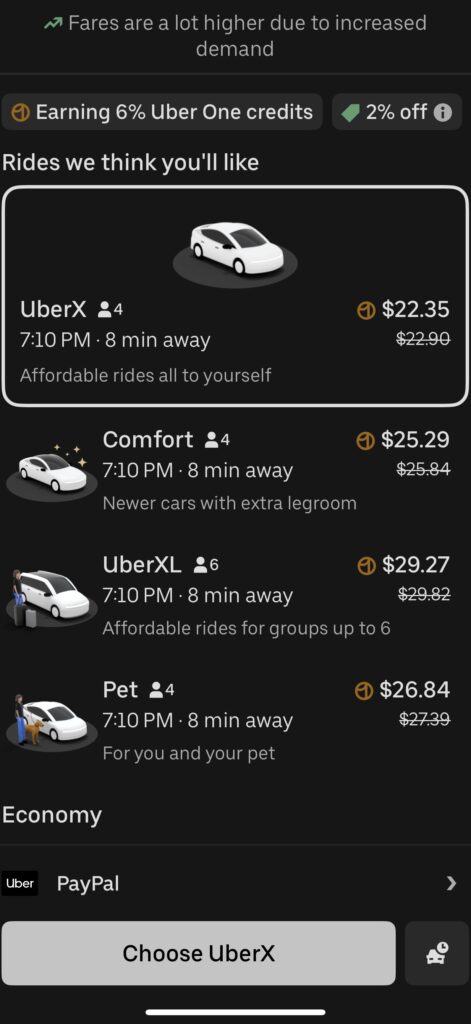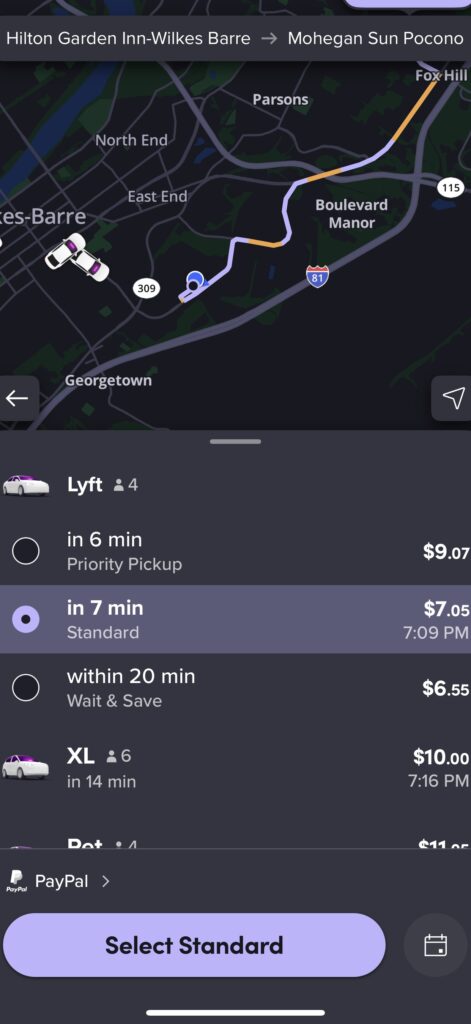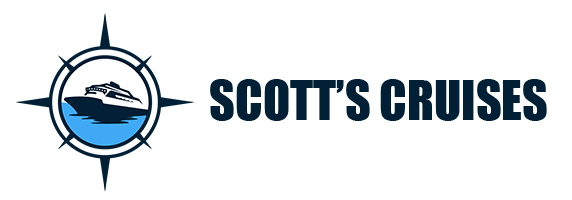For cruise travelers, the journey doesn’t end at booking your cabin or packing your sunscreen—getting to and from the port, airport, or hotel smoothly is just as crucial. This is where ride-sharing services like Uber and Lyft come in, offering convenience for cruisers looking to navigate their travel logistics with ease.
Whether you’re hopping from the airport to the cruise port, zipping from the port to a hotel, or heading back home, these apps make transportation a breeze with just a few taps on your smartphone. But while Uber and Lyft are incredibly convenient, they’re not always equal in price or availability. That’s why cruise travelers should always price shop between these services to ensure they’re getting the best deal—and we’ll cruise into why, using real examples from the apps to illustrate the importance of comparison.
The Convenience of Ride-Sharing for Cruisers
For anyone who’s ever tried hailing a taxi in an unfamiliar city or coordinating a private driver, ride-sharing services like Uber and Lyft are a game-changer, especially for cruise travelers. With a few clicks on your smartphone, you can summon a ride to whisk you from the airport to the port, from the port to your hotel, or back to the airport after your cruise ends. No need to stand on a curb waving frantically, no need to negotiate fares, and no need to worry about cash or tipping etiquette—everything is handled seamlessly through the app.
Cruise ports, often located in bustling areas or near major airports, benefit from the sheer volume of Uber and Lyft drivers in these regions. This high density of drivers means wait times are typically low, which is a lifesaver for cruisers on tight schedules. Missing your ship’s departure or a flight home because of transportation delays is a nightmare no one wants to experience, and ride-sharing services help mitigate that risk with their quick response times. Whether you’re disembarking a ship with hundreds of fellow passengers or arriving at a busy airport, you can trust that an Uber or Lyft driver is likely just minutes away, ready to get you where you need to go.
How Uber and Lyft Work
To understand why price shopping between Uber and Lyft is so important, it helps to know how these services operate. Both Uber and Lyft are on-demand transportation platforms that connect passengers with drivers through a mobile app. Here’s a quick rundown of how they work:
- Download the App: You download the Uber or Lyft app on your smartphone and create an account, linking a payment method like a credit card or PayPal.
- Request a Ride: Open the app, enter your pickup location and destination, and choose your ride type—options typically include Economy (standard cars), XL (larger vehicles for groups), Comfort (newer, more spacious cars), and specialty options like Pet-friendly rides or wheelchair-accessible vehicles.
- Get a Quote: The app provides an estimated fare and arrival time based on factors like distance, traffic, demand, and the type of ride you select.
- Meet Your Driver: Once you request a ride, a nearby driver accepts your request, and you can track their location in real-time on the app’s map. The driver picks you up, and you’re on your way.
- Pay Through the App: Payment is processed automatically through your linked payment method, and tips can be added via the app if you choose.
Both services use dynamic pricing, also known as surge pricing, which means fares can fluctuate based on demand, time of day, and location. During peak times—like early mornings at airports or late afternoons near cruise ports—prices can spike significantly. This is where the convenience of Uber and Lyft can sometimes come at a cost, making price comparison between the two services essential.
The Importance of Price Shopping: A Real-World Example
While Uber and Lyft operate similarly, their pricing and availability can differ, even for the same route and time. Failing to compare can lead to overpaying—or missing out on a better option altogether. Let’s look at two screenshots from the apps, both showing ride options for a trip from the Hilton Garden Inn in Wilkes-Barre to Mohegan Sun Pocono, to illustrate why price shopping matters.

In the Uber app, the ride options for this route include:
- UberX (up to 4 passengers): $22.35 with Uber One credits, or $22.90 without, arriving at 7:10 PM and 8 minutes away. This is described as an affordable ride for individuals.
- Comfort (up to 4 passengers): $25.29 with Uber One credits, or $25.84 without, also arriving at 7:10 PM and 8 minutes away, featuring newer cars with extra legroom.
- UberXL (up to 6 passengers): $29.27 with Uber One credits, or $29.82 without, arriving at 7:10 PM and 8 minutes away, suitable for groups.
- Pet (up to 4 passengers): $26.84 with Uber One credits, or $27.39 without, arriving at 7:10 PM and 8 minutes away, designed for travelers with pets.
The app notes that fares are higher due to increased demand, and there’s a 6% Uber One credits earning opportunity, along with a 2% discount. The default selection is UberX at $22.35, but the price difference between options is notable, with the Pet ride being $4.49 more expensive than UberX and UberXL costing even more for larger groups.

In the Lyft app for the same route, the options are:
- Lyft (up to 4 passengers): $9.07 for Priority Pickup (6 minutes away, 7:07 PM), $7.05 for Standard (7 minutes away, 7:09 PM), and $6.55 for Wait & Save (within 20 minutes).
- XL (up to 6 passengers): $10.00, arriving in 14 minutes at 7:16 PM.
- Pet (up to 4 passengers): $11.05, with a similar arrival time.
The default selection is Standard at $7.05, but the Priority Pickup option costs $2.02 more for a faster arrival, and Wait & Save offers a $0.50 savings for a longer wait. The XL option for groups is $2.95 more than the Standard ride, and the Pet option is significantly higher at $11.05.
Why the Price Difference Matters for Cruisers
Comparing these screenshots reveals a striking disparity: for the same route, Lyft’s Standard ride is priced at $7.05, while Uber’s cheapest option (UberX) is $22.35—a difference of $15.30! Even Lyft’s most expensive option (Pet at $11.05) is still cheaper than Uber’s cheapest ride. This gap highlights why cruise travelers must check both apps before booking. Factors like demand, driver availability, and surge pricing can cause prices to vary widely between Uber and Lyft, even for identical routes and times.
For cruise travelers, every dollar counts—whether you’re saving for onboard excursions, souvenirs, or your next cruise. Overpaying for a ride to or from the port can add up, especially if you’re traveling with a group or have multiple legs of your journey (airport to hotel, hotel to port, port to airport). By taking just a minute to open both apps, enter your route, and compare prices, you could save significant amounts. In the example above, choosing Lyft over Uber could save you enough to buy a nice drink on the ship or cover parking fees.
Additional Considerations for Cruisers
Beyond price, there are other factors to consider when choosing between Uber and Lyft:
- Availability: Check which service has more drivers available at your pickup time, especially during peak cruise embarkation or disembarkation periods.
- Ride Options: If you’re traveling with a pet, a group, or need extra legroom, ensure the service offers the right vehicle type at a reasonable price.
- Surge Pricing: Both apps use surge pricing during high demand, but the extent can differ. Look for alerts in the app (like Uber’s “Fares are a lot higher due to increased demand”) and compare if one service is surging more than the other.
- Loyalty Programs: Uber One and Lyft’s equivalent programs (like Lyft Pink) offer discounts or credits that can affect your final cost. In the Uber screenshot, the 6% Uber One credits and 2% off could sway your decision if you’re a member.
Tips for Price Shopping Like a Pro
To maximize savings and convenience as a cruise traveler, follow these tips:
- Check Both Apps Simultaneously: Open Uber and Lyft side by side, enter your route, and compare prices and arrival times.
- Look for Promotions: Check for any loyalty program discounts, credits, or promo codes in either app.
- Be Flexible with Timing: If you can wait a few extra minutes (like Lyft’s Wait & Save option), you might save money.
- Monitor Surge Pricing: Avoid booking during peak times if possible, or wait out a surge if it’s temporary.
- Plan Ahead: For busy cruise ports or airports, book in advance or check prices early to avoid last-minute surprises.
Ride-sharing services like Uber and Lyft are indispensable tools for cruise travelers, offering convenience, low wait times, and flexibility that taxis and private drivers can’t match. However, their pricing isn’t always identical, and failing to compare can lead to overpaying—sometimes by double or more, as seen in the Wilkes-Barre to Mohegan Sun Pocono example. By taking a moment to price shop between the two apps, you can ensure you’re getting the best deal for your journey, leaving more room in your budget for the experiences that make cruising so memorable.
So, before you tap “Confirm Ride,” open both apps, compare your options, and cruise into your next adventure with confidence—and a little extra cash in your pocket.
